This basil pesto recipe is much more flavorful than store-bought and so easy to make. Grab fresh basil, pine nuts (or walnuts), garlic, parmesan, and quality extra virgin olive oil and it’s ready in 10 minutes. Make it ahead, refrigerate or freeze, and keep on hand for weeknight pesto recipes—I’ve listed all my favorites!
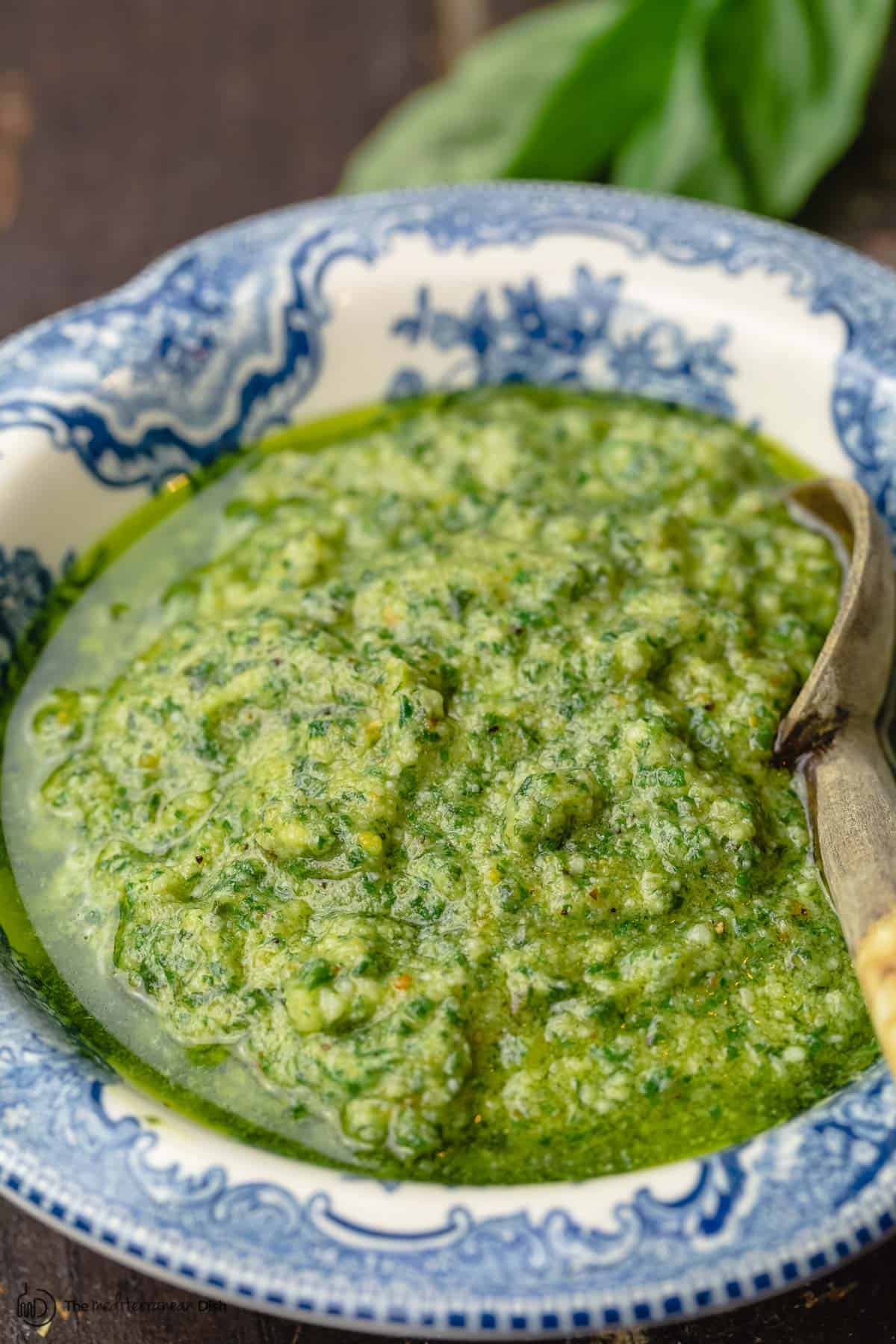
Basil pesto is traditionally made with fresh basil pounded with pine nuts, aged cheese, and olive oil in a mortar and pestle. It gets its name from “pestare,” the Italian word for “to pound” or “to crush.”
I adapted the traditional recipe with a few tricks to keep the pesto’s vibrant green color and fresh, aromatic flavor for longer. A quick blanch in boiling water and a squeeze of lemon juice means this sauce will last in your fridge for up to 2 weeks and your freezer for up to 6 months! And, I make it in a food processor or blender so you just have to push a button.
Though this is a decidedly easy pesto recipe, it has the same richness that’s made pesto one of the most iconic Italian sauces of all time. I use it all day long! Fry eggs in pesto for a healthy savory breakfast. For lunch, spread onto eggplant parmesan sandwiches. For dinner, pesto pasta, creamy chicken pesto pasta, baked pesto sea bass, pesto salmon, and pesto chicken are ready in under 30 minutes! All you really need to enjoy a good pesto, though, is some good crusty bread.
Table of Contents
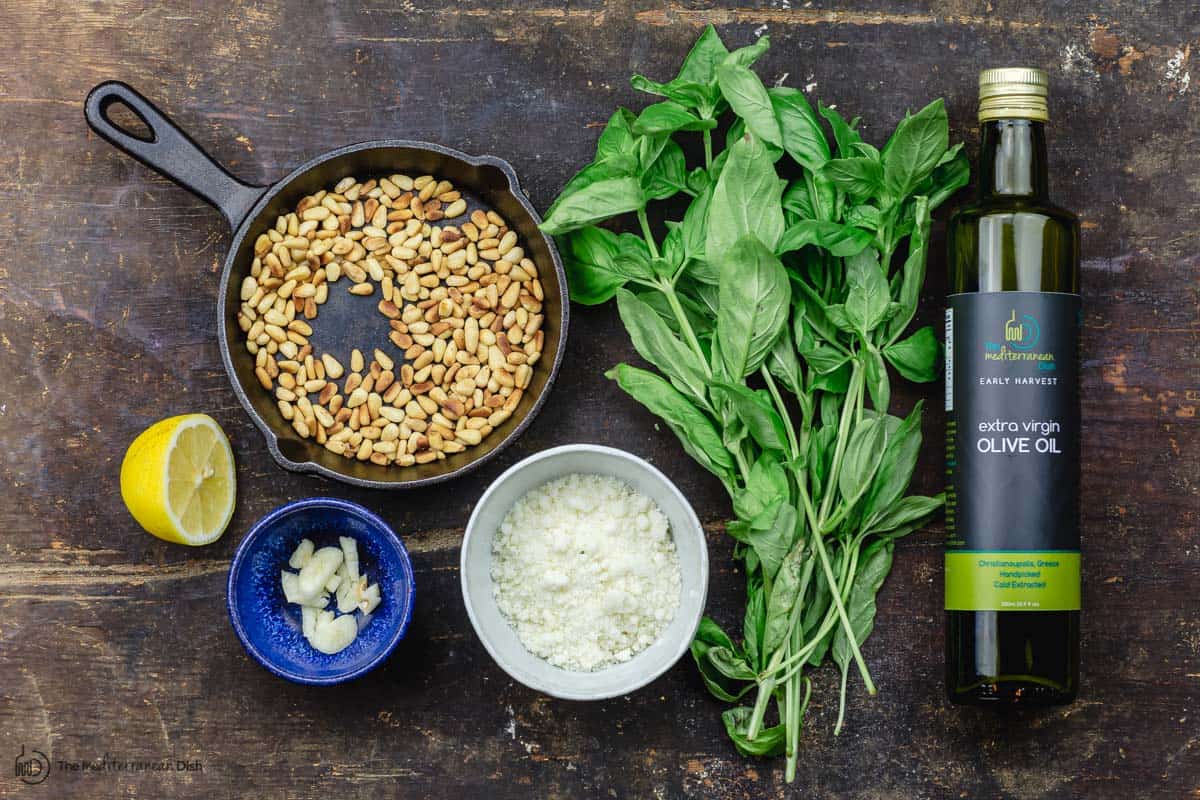
Ingredients for Basil Pesto
This easy basil pesto recipe uses just a handful of ingredients to make a simple sauce with so much depth and richness. Like with any recipe that uses just a few ingredients, you’ll want each one to be fresh and flavorful.
- Basil: Fresher basil and high quality olive oil are the two biggest differences between homemade and store-bought pesto. Grab the freshest basil you can find with little signs of limpness or browning. And, try to pack the two cups with the smaller, more tender leaves for the best flavor. If you’re not making pesto on the same day you go shopping, check out my tips for how to store fresh basil so it lasts.
- Garlic: Increase the garlic to your heart’s desire, but 1-2 cloves typically brings enough punchiness without overpowering the delicate qualities of the basil.
- Nuts: Buttery, creamy pine nuts are more traditional if you can swing it, but I know they can be expensive. Walnuts also work well and are more economical. Toast both in the oven at 325°F until they’re golden brown. Keep a close eye as nuts burn easily!
- Lemon: Lemon juice both adds brightness and prevents the basil from browning.
- Olive oil: With so few ingredients, olive oil has a major influence on how a pesto tastes. A high quality extra virgin olive oil is another opportunity to greatly improve your pesto! Use a smooth but full-flavor olive oil. I love our buttery but bold Italian Nocellara. For a full guide to buying pesto, check out our guide: Olive Oil 101: Everything You Need To Know.
- Parmesan: Parmesan cheese adds a deep umami quality that makes pesto irresistible. Grab the whole blocks (rather than pre-grated parm) as they tend to be much higher quality and fuller flavor.
- Seasoning: Pesto uses only kosher salt and black pepper to enhance the flavor. Add just a small pinch of salt and adjust from there, as the parmesan naturally adds saltiness.
How to Make Basil Pesto
This basil pesto recipe is made in a food processor or blender, so it comes together in just 10 or so minutes. A quick blanch and a squeeze of lemon is all you need to keep the basil’s vibrant green color. To make basil pesto:
- Get ready: Fill a small saucepan halfway with water and bring to a boil. Prepare a bowl of ice water and set it near your stove. Set up a food processor with the blade attachment (or get your blender all plugged in and ready).
- Briefly blanch the basil. Drop 2 packed cups of basil leaves in the boiling water. Blanch just until the leaves wilt, 5 to 10 seconds. Use tongs to transfer the basil leaves to the prepared ice water. This stops them from continuing to cook.
- Dry the basil very well. Wrap the basil in paper towels. Squeeze to wring out all the water and transfer to the food processor. Add 1-2 chopped cloves of garlic, 1/3 cup of toasted pine nuts (or walnuts), and the juice of 1/2 lemon.
- Blend. Pulse until everything has broken down into small chunks. With the processor running on low speed, slowly pour in 1/2 cup of extra virgin olive oil. Do not run the processor too long, you want to have a little bit of texture.
- Stir in the parmesan. Transfer the basil mixture to a small bowl. Add 1/2 cup of finely grated parmesan cheese and stir to incorporate. Taste and season with salt and pepper to your liking. If your pesto is looking a little thicker or less smooth than you like it, add a little bit more extra virgin olive oil.
- Serve or store. Use immediately or store for later (see tips for how to use and store basil pesto below).
How to Store Basil Pesto
To store pesto, transfer it to a mason jar and cover with a layer of olive oil (this will “seal it” and prevent it from browning from exposure to air). Seal tightly and store in your fridge for up to two weeks. To use, simply scoop off the oil. Be sure to replenish that top layer of extra virgin olive oil to keep it nicely sealed (always use a clean spoon and return it to the fridge).
Can you Freeze Basil Pesto?
Yes! You can freeze pesto for up to 6 months and thaw it in your fridge the night before you plan to use it. Here are two ways to freeze pesto:
- In a freezer-safe jar. Cover with a layer of extra virgin olive oil and freeze. I do this when I plan to use the entire amount in a pasta dish.
- In ice cube trays. If you want to be able to use a little bit of pesto at a time, pour it into ice cube trays and freeze for 1 hour or until hard, then transfer the cubes to freezer bags.
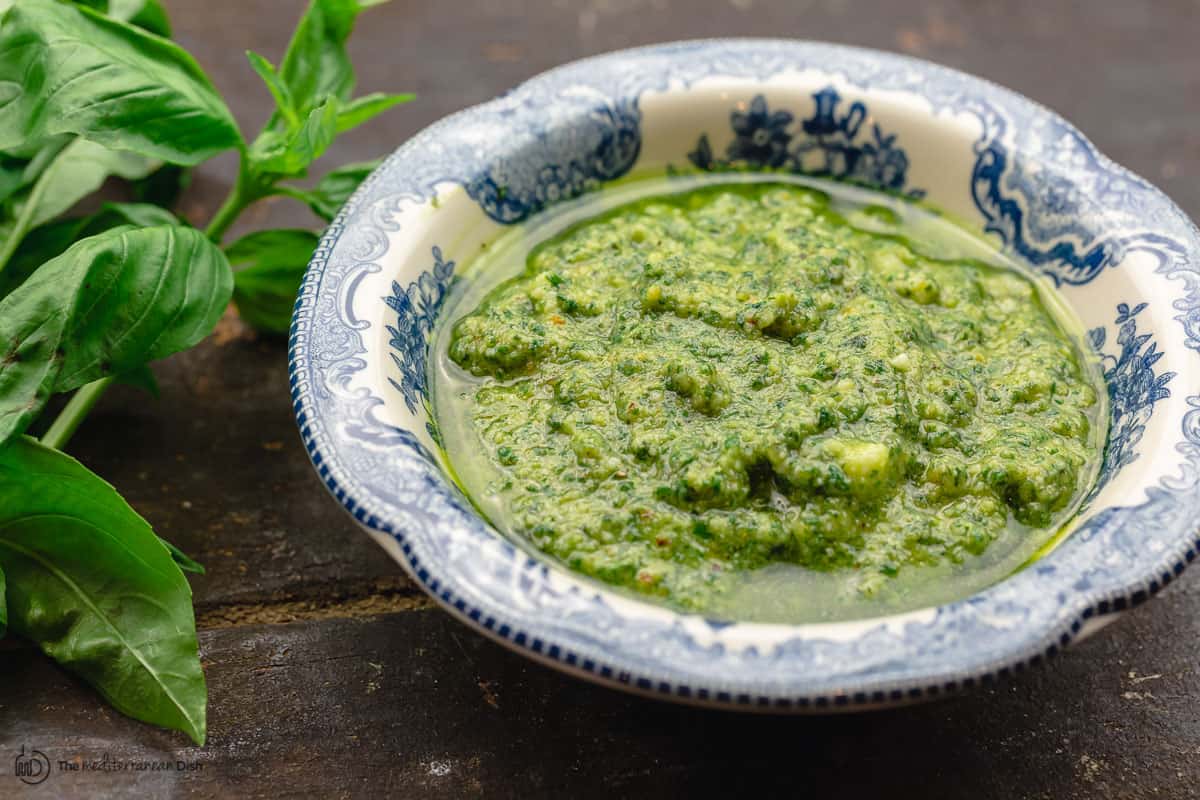
How to Serve Basil Pesto
Basil pesto is a true workhorse in the kitchen. It’s easy to make, keeps well, and just a spoonful instantly adds herbal, creamy, umami-rich flavor. Keep pesto on hand for quick and delicious meals all week long!
Make yourself a 5-minute snack with toast, sliced tomatoes, a drizzle of extra virgin olive oil, and a spoonful of pesto. Or, use as a dip for crusty bread. Rosemary Focaccia with Roasted Garlic still warm from the oven and dipped in homemade pesto is a simple luxury that reminds me why I love Mediterranean food.
For a full meal:
- Serve with fish. Spoon a dollop over grilled salmon, sea bass, or fish en papillote to give a weeknight dinner a cheffy flair.
- Toss with pasta. A box of pasta and some pesto is all you need, but you can easily dress it up with tomatoes and mozzarella, ravioli and peas, or broccoli and lemon.
- Serve with chicken. Pesto chicken and vegetables are on your table in 20 minutes with this one-pan weeknight recipe.
- Use as a sandwich spread. Make a Mediterranean-style grilled cheese on pita bread with mozzarella, feta, spinach, sun dried tomatoes, and basil pesto. Or, make an open-face eggplant parmesan sandwich.
- To liven up a vegetarian dinner. Braise chickpeas in a creamy pesto sauce for an extra comforting, quick, and filling vegetarian meal. Or make the light yet filling vegetarian stuffed peppers with basil vinaigrette.
- Start your morning right. Fry your eggs in basil pesto and enjoy with crusty bread.
Top Four Favorite Ways to Use Pesto
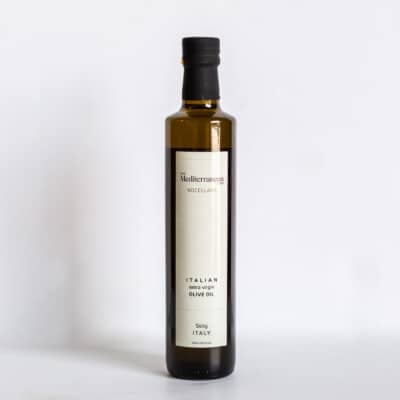
Try our Italian Extra Virgin Olive Oil
It’s the perfect choice for your next batch of pesto. Smooth, buttery, and full of flavor!
Browse all Mediterranean recipes.
Visit Our Shop.
Basil Pesto Recipe
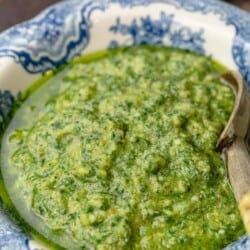
Ingredients
- 2 cups packed basil leaves
- 1 to 2 clove garlic, chopped
- 1/3 cup pine nuts or walnuts, toasted
- Juice of 1/2 lemon
- 1/2 cup extra virgin olive oil
- 1/2 cup finely grated Parmesan cheese
- Kosher salt
- Black Pepper
Instructions
- Get ready: Fill a small saucepan halfway with water and bring to a boil. Prepare a bowl of ice water and set it near your stove. Set up a food processor with the blade attachment (or get your blender all plugged in and ready).
- Briefly blanch the basil: Drop the basil leaves in the boiling water and blanch just until they’re wilted, 5 to 10 seconds. Use tongs to transfer the basil leaves to the prepared ice water. This stops them from continuing to cook.
- Dry the basil very well: Wrap the basil in paper towels. Squeeze to wring out all the water and transfer to the food processor, along with the garlic, pine nuts, and lemon juice.
- Blend: Pulse until everything has broken down into small chunks. With the processor running on low speed, slowly pour in the extra virgin olive oil. Do not run the processor too long, you want to have a little bit of texture to your basil pesto.
- Stir in the parmesan: Transfer the basil mixture to a small bowl. Add the cheese and season with salt and pepper to taste. Mix to combine. If your pesto is looking a little thicker or less smooth than you like it, add a little bit more extra virgin olive oil.
- Serve or store: Use immediately or store for later (see “Notes” below for storage tips).
Video
Notes
- Toast nuts in the oven at 325°F until they’re golden brown. Keep a close eye as nuts burn easily!
- Storage: Transfer the pesto to a mason jar. Cover with a thin layer of extra virgin olive oil (this creates a seal and prevents air from getting to it). Cover tightly and refrigerate for up to two weeks. As you use some of the pesto over time, be sure to replenish the thin layer of extra virgin olive oil on top.
- To Freeze: Freeze in a tightly-closed freezer-safe jar with a thin layer of olive oil on top for up to 6 months. Or, if you want to freeze it in smaller amounts, pour the pesto into ice cube trays and freeze until hard. Once frozen, transfer the pesto cubes to a freezer-safe bag.
- Visit our shop to browse quality Mediterranean ingredients including olive oils, honey, jams, and spices.

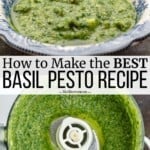
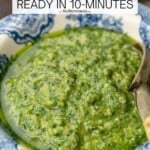
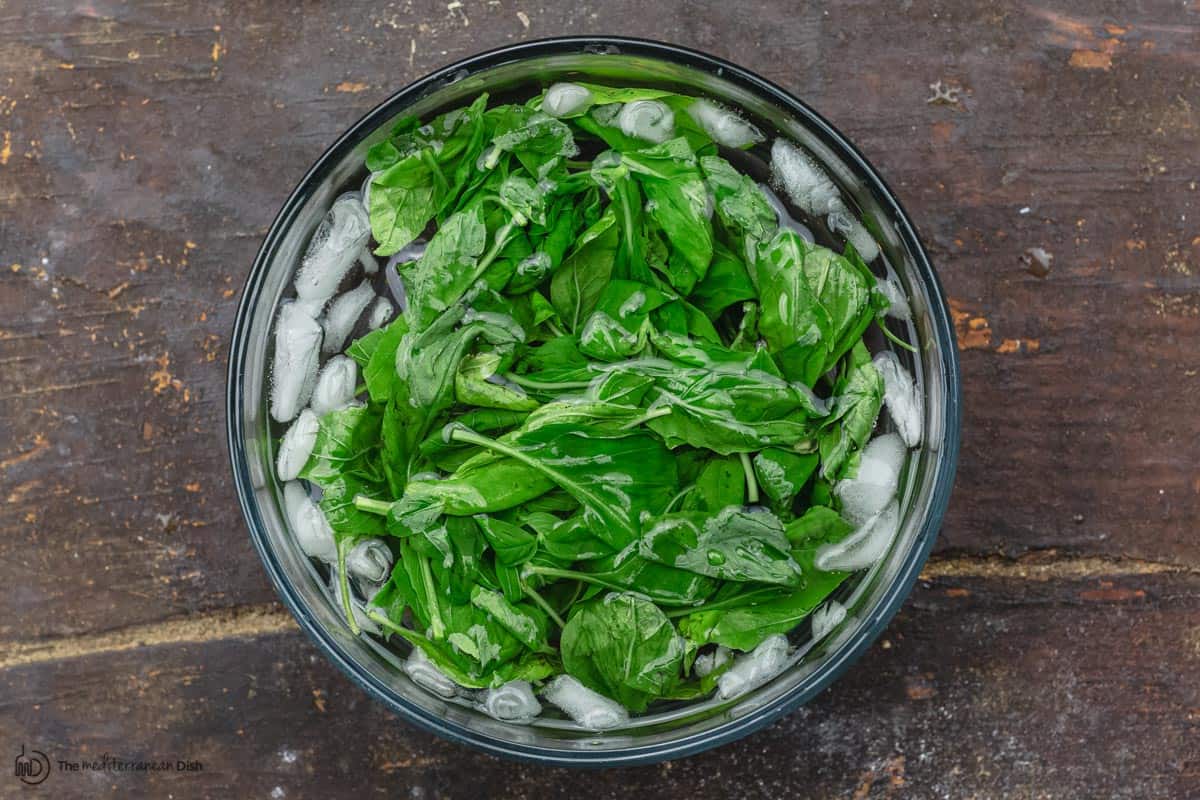
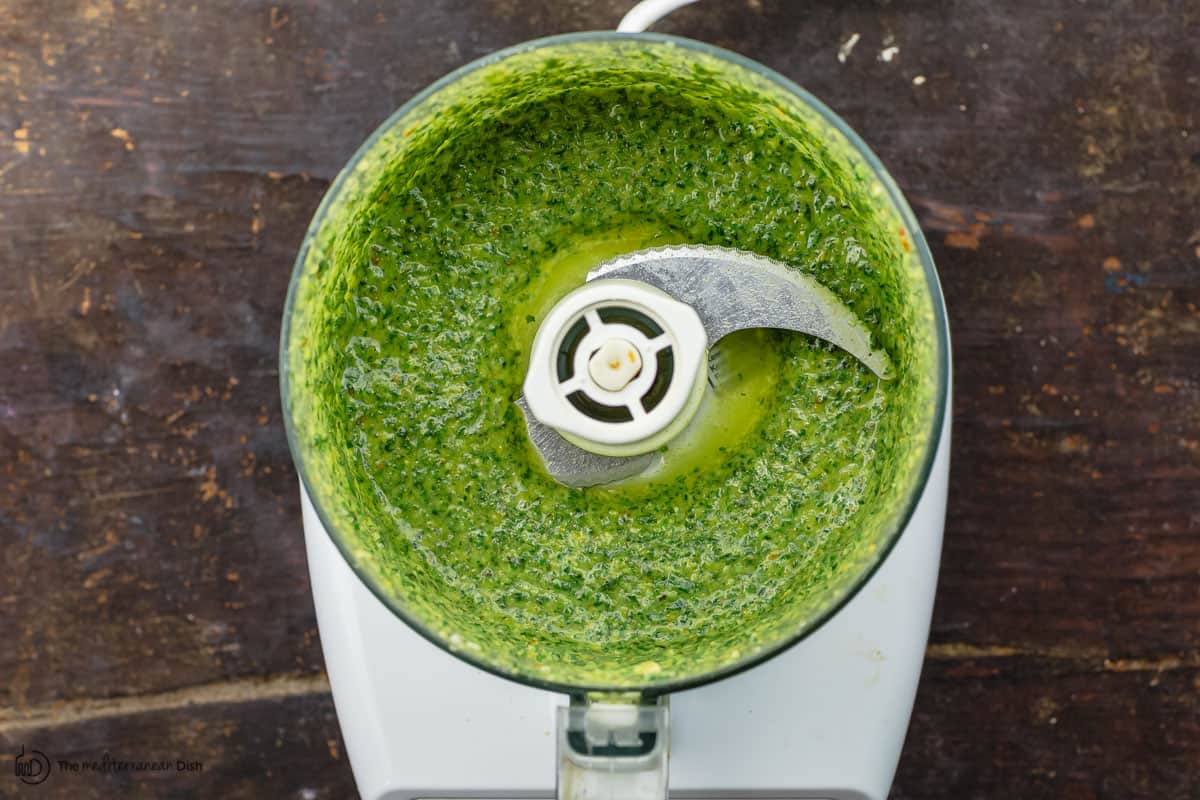
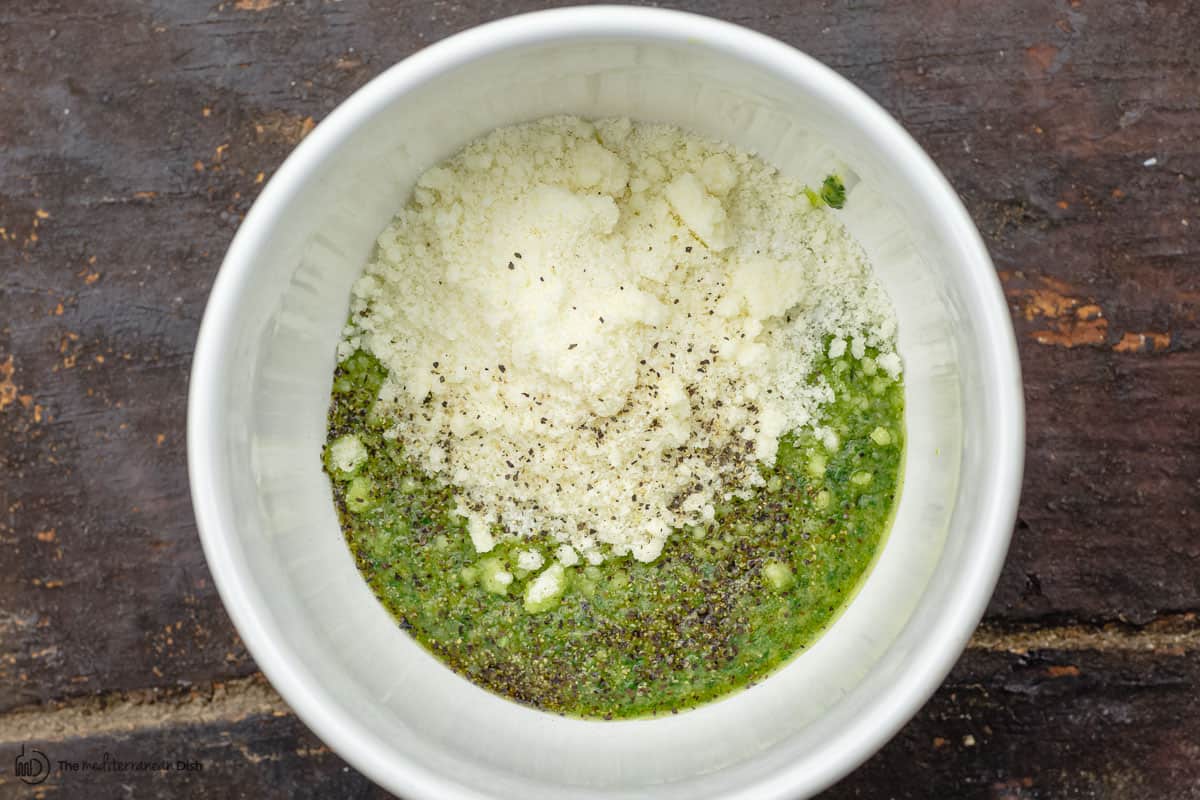

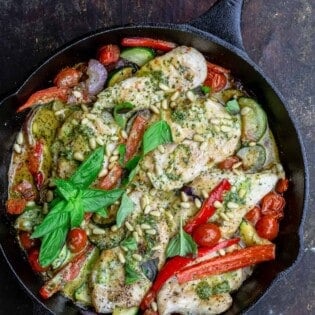
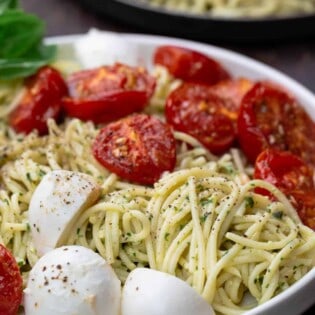
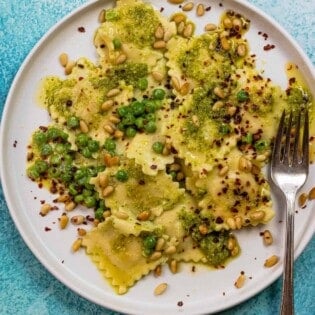
I love this so much and make it often. I could literally eat it out of the jar with a spoon!
LOL! Me tooooo!
I can think of so many ways to use this! Cannot wait!
Enjoy!!
I really loved how easy this is to make!! Thanks for sharing!
This is such an easy pesto to make, very tasty!!
This fresh basil pesto is couldn’t look any more perfect!
Thank you, Erin! Hope you enjoy it!
I love basil pesto on practically everything! I love how simple and easy this is!! Thank you so much!
Thanks, Allyson!
Thanks for including the sodium content in the nutritional info on your recent recipes. Much appreciated by me.
So glad it’s been helpful, Mark!
This basil pesto is very easy to prepare, and it was delicious with a simple spaghetti for a refreshing and quick lunch.
Thanks for sharing, Anita!
This pesto recipe was great! Loved all the fresh flavors happening and it was so easy to make.
So glad you enjoyed it, Emily!
I am in love with your recipes, and this one is not an exception! Made this basil pesto this morning: it is worth trying!
Thanks so much, Irina!
Followed this pesto recipe to the letter and it was the BEST I have ever tried! And I’ve been making pesto for a long time! Thanks for all the great tips
My pleasure, Cindy! So glad you loved it!!!
I love the tip of freezing it in an ice cube tray! Easy to store and easy to throw into a recipe.
Thanks, Angela!
Hi Suzy,
I love your recipes! and so does my family.
You are amazing, thank you.
Thank you! So glad to hear it.
Can I use an immersion blender? I don’t have a food processor or mortar & pestle.
That’s very possible, Angela! You can use a bowl and an immersion blender.
I have never seen someone blanche the basil for pesto, at least none of the T.V. chefs do. What is the purpose for blanching it?
Would you recommend using the same method for spinach pesto?
Hi Katrina, in the body of the post, I explained that blanching the basil helps keep the pesto’s bright green color. Here is that section again, in case you did not see it: “Blanch the fresh basil. This step takes just a few seconds. You place the basil in a boiling pot of water for 5 to 10 seconds max, then transfer it quickly to an ice bath to stop cooking. And before using it, make sure you wring out all the water. Blanching is meant to kill off the decomposing enzymes that are responsible for turning the leaves brown. Fine Cooking also claims that this trick helps create a better emulsion.”
And if you do plan to freeze some spinach, blanching is not a bad idea.
I have so much basil from my friend’s garden and I am so excited to try your tips and make homemade pesto! Thank you so much for the video too!
Awesome, Cindy! Enjoy